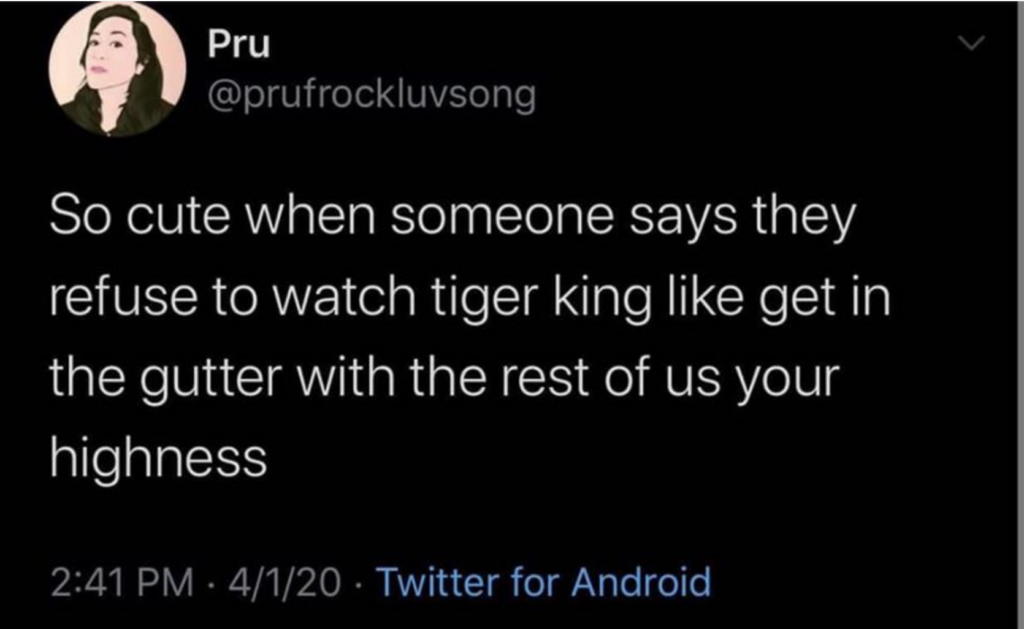

Last post in our ‘Introduction to Writing’ series, we discussed how stories are namely a collision of IDEAS. I also introduced the core antagonist, what I call the BBT…or Big Boss Troublemaker.
Sorry for the delay in posts. This quarantine has been…wow. Who knew March had 666 days? It’s like 2020 was doing just fine, then March came flying in screaming, ‘Leroooooooy JENKINS!’
There’s been good reason for the delay. First, I have part of my family quarantined in Northern Italy, and then last week my nephew went to the hospital and tested positive for COVID19. And he lives with my 67 year old mom. *face palm*
Last week I just…didn’t get to the blog. Btw, everyone is fine for now. Nephew home and better. Mom and family in Italy so far have not gotten sick. *fingers crossed*
Moving on…
Like a lot of the cooped up world, seems we can’t help but have heard all about the Big Boss Troublemaker, Carol %$#&!@ BASKINS. Even if Carol Baskins is a BBT conjured in the meth-addled brain of megalomaniac Joe Exotic, without Carol?
Hundreds of millions of bored quarantined people would never have heard of a bat$#!@ crazy gay zookeeper from Oklahoma or the train wreck that is Tiger King.
*evil laugh* We’ll get there…
Anyway, the BBT is our central opposition. This is the force responsible for creating the core story problem in need of resolution. While stories have all sorts of ‘antagonists’ we’ll get to them another time.
The CORE (IDEA)
The BBT is a wholly unique sort of antagonist. This specific antagonist, the Big Boss Troublemaker, is the Baskins BRAIN of all great stories. Why? Because all great stories involve an IDEA that must be defeated. We talked about this last time.
Fantastic. But, how do we do this?
Great stories are almost like living creatures. Like all living creatures, there are critical limitations when it comes to structure. What this means is not all ‘components’ are equally necessary for an organism to be considered ‘alive.’
If a kitten is born with no hair? We call it a Sphynx then sell it for big bucks to people who adore cats that resemble space aliens.
If our kitten is born with unusable back legs, it’s sad. But, we humans get creative and craft a Lego ‘kitten wheelchair’…producing a kitten now drunk with power. ZOOOOOOM! LOOK AT HIM GO ALL THE PLACES!
Ah, but a kitten born with no brain stem? Little to do but mourn. We can’t work around this missing ‘organ,’ no matter how much we may want to. Regardless how creative we get, actual life requires a brain that directs every other system.
The Living Story
We can say the same about story. It, too, must have a brain (core story problem/IDEA generated by BBT).
Some ‘elements’ of story are not, per se, required because they’re NOT the brain. These ‘components’ might simply be a matter of stylistic choice.
Loads of detailed description and weighty prose? Unnecessary. For instance, Hemingway’s Old Man and the Sea. Hemingway chose literary austerity to elicit a highly specific ‘feel’ in his work. Bold, exposed, nowhere to hide. No flowery exposition to ‘cover’ any plot weakness.
I happen to love flowery prose, which is why I don’t care for Hemingway’s stories but can respect the art.
***Bet you never thought anyone would put Ernest Hemingway and Joe Exotic in the same blog post. Did ya? Did ya?
Linear plotting, as in Point A to Point Z in sequence and in order? Not necessary either.
Sure, this three-act linear Aristotelian structure is the most common and the best place (in my POV) for emerging writers to begin and to master FIRST. It also happens to be the easiest structure on readers, which is why it’s the structure most commonly used.
But, again? It is not imperative for our story to progress linearly in time. This, again, is a stylistic choice and will often be employed for a purpose. There’s a specific effect the author desires to create.
Examples of Structure as Art


Purple prose and a hundred-page lexicon of new terms, kingdoms, creatures are not the only ways (or even the best ways) to transition a story into art. Structure, when truly understood, is extremely powerful.
For instance, Chuck Palahniuk deliberately used nonlinear plotting for Fight Club. Gillian Flynn also employed nonlinear structure in Gone Girl.
Why? These authors chose these advanced plotting methods for excellent and very specific reasons: to craft the unreliable narrator.
Anthony Horowitz uses a timeline within a timeline in The Magpie Murders. Horowitz threads a fictional and prototypical Agatha Christie-style British whodunnit into a real life murder mystery.
When Alan Conway, mega-author of the runaway successful Atticus Pünd series—and bread-and-butter top-earner of the publisher—dies mysteriously, the final chapters of his latest manuscript are missing. Is it an oversight or a clue that something far more nefarious is afoot?
The dueling timelines are woven together brilliantly. Solve the fictional murder and solve the real one and vice versa.
Brilliant stuff.
Yet, we must grasp the BBT or it’s impossible to create a simple linear plot. Forget about the fancy tricks. It imperative to fully grasp the power of the BBT or characters fall flat and stories will struggle to break out from the ‘meh.’
So, basics first.
Dead or Alive?


It doesn’t matter if we choose to use tons of detailed description or almost none, if we plot linearly or nonlinearly. We can include maps, made-up languages, on and on.
These are all stylistic preferences which can all work so long as at the center of it all, the story must have a BRAIN (the idea).
The BBT is the IDEA that creates the core problem in need of resolution/defeat. Every book mentioned above has a Big Boss Troublemaker (and corresponding proxy/proxies).
Problem is, far too many emerging writers spend far more time pondering the color of their main character’s eyes (amethyst or peridot…no jade!) than they do considering what the heck the MC is even up against.
WHY does he/she/it exist?
The BBT is the sole reason for our MC (main character) to exist. Period.


Whenever I blog about the BBT, inevitably I get the whole ‘But my MC is his/her own worst enemy’ counterpoint (which really isn’t a counterpoint at all).
Let’s go back to Joe Exotic to make my point because he does this so well. You don’t even have to watch the show to get the story. If Carol Baskins had never entered Joe’s life, likely we’d never have heard of him.
But, she did and Joe cast himself as the hero and her as the villain to be thwarted.
Without Carol’s desire to shut down Joe, there is no story. We’d be left with The Jerry Springer Show with tigers. Yet, by adding in ONE element—Carol Baskins—now we have more.
Also, this ties into my preference for a BBT. I like for the antagonist to make a really good case. When it isn’t easy-peasy black and white, it makes for a better story (my POV).
In the Joe Exotic saga, the memes have been flying (like above). Joe is SO OVER THE TOP upset with one person and taking zero responsibility for his own bad choices. No, it’s all another person’s fault.
Sure.
But, if we look at Carol, she brings an excellent argument to the table, which is WHY she is such a good foe.
Joe believes in breeding tigers. He feels that people won’t part with money to save what they can’t see, touch and have a personal experience with.
Conversely, Carol and her organization is there to pick up the mess of what happens when people are reckless with owning exotic animals. She wants to stop the breeding because she’s seen the dark side of the animals being neglected or harmed and she’s had to bring in animals who’ve been abused.
Both Joe AND Carol make very good points…which is WHY this is a seriously interesting story. That and just about everyone involved in this drama pileup is crazy or a sociopath.
Sigh.
The MC as BBT


I would also like to use Joe to shut down the ‘my MC IS his/her own worst enemy and thus the antagonist’ argument. First, a properly crafted MC always is his or her own worst enemy, especially in the beginning. It’s what makes stories interesting. If Joe made good decisions, Tiger King wouldn’t be hitting #1 on Netflix.
But let’s get back to the world of fiction. We don’t know if Joe will ever arc, though I suspect it’s a morbid mob curiosity to wait and see if he DOES mend his ways that keeps people watching.
This is why the character must arc in order to win. If our MC is flawless and fully self-actualized and able to overcome the BBT from the starting gates, this is not a story, it’s a sedative.
Bad decisions are the beating heart of great fiction.
We don’t pick up a book or watch a series to see people who make all the right decisions in life. That is the realm of self-help and non-fiction. When it comes to telling a really good story, the messier the better.
Granted, we have to balance that fine line of flawed and ‘Too Dumb to Live’ but perfect people make for lousy stories.
This is generally why most video games don’t translate well into movies. The characters are too flat and have nowhere to grow.
But the central point I want to make is that the BBT is the best place to start with your novel/story. Once you have the BBT pegged? Everything else falls into place a LOT easier.
Remember, Tiger King without Carol Baskins is just The Jerry Springer show with lions. Carol Baskins is the key ingredient that transforms what could have just been a bunch of meth-addled vignettes into a revenge-and-cocaine-fueled story.
Rules of a Strong BBT


BBTs manifest differently depending on genre. This is why it helps to have at least a basic idea what genre you’re writing when you’re coming up with your plot. Genre is VERY helpful. It will help you find readers and readers find YOU.
Genre will impact your BBT, namely because a rule of the BBT is that your MC must defeat the BBT in Act Three. Once our lowly protagonist has learned all the lessons and evolved into a hero, he/she is then finally equipped to face down the opposition.
If you’re writing romance, then you need a Happily Ever After or at least the more modern Happily For Now. Utter defeat not a great start for a relationship.
This is why romance written in what is referred to as a ‘buddy love structure’ where the two come together to defeat the BBT in the end.
Overall though, the ‘rules’ for the BBT are pretty simple. The BBT needs to be introduced early either directly—Carol Baskins—or via a proxy or an effect.
In mysteries, the BBT is introduced via the dead body. Thrillers it might be an attack on an embassy. We see early on some extension of the BBT and his/her/its agenda.
The BBT must be far stronger than your MC can handle in the beginning. In fact the entire point of the story is to refine SOME characteristic your MC lacks that is critical for the final showdown.
If it is a mystery or thriller, then the MC is lacking in information. The BBT knows all the information and the MC is in the dark. This genre generally doesn’t have a lot of character development and is heavy on procedurals and fight scenes and a race to figure out what happened.
Other genres, there can be some personal flaw, a blindspot, a secret, a shame, which we’ll go into at another time. Some personal demon that has to be dealt with in order to rise to the occasion and defeat the BBT.
Just remember, the greater the odds of failure, the better the story. We want to be on the edge of our seats wondering how on EARTH the MC is going to pull it off. If everything comes too easily? We’ll wander off and go watch Tiger King.
What Are Your Thoughts?
I do love hearing from you. Where you struggle, because we ALL do. What you want to know more about? Where you get stuck, etc.
I look forward to helping you guys become stronger at your craft. What are some of your biggest problems, hurdles or misunderstandings about plot? Where do you most commonly get stuck?
I love hearing from you!
My goal is to get back on track with regular post. If there is some area that is particularly a sticky wicket you’d like me to address, toss it in the comments!
